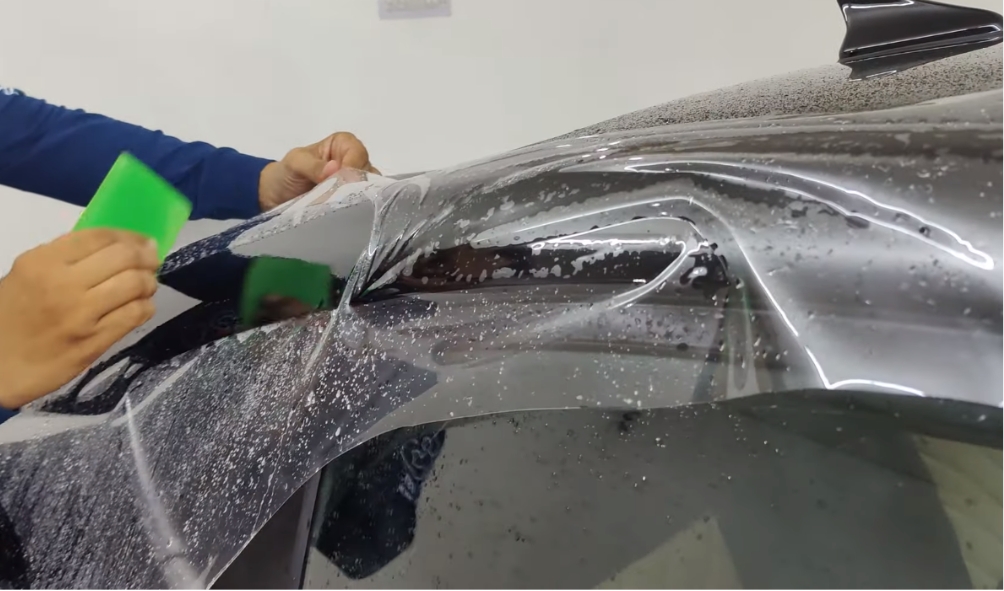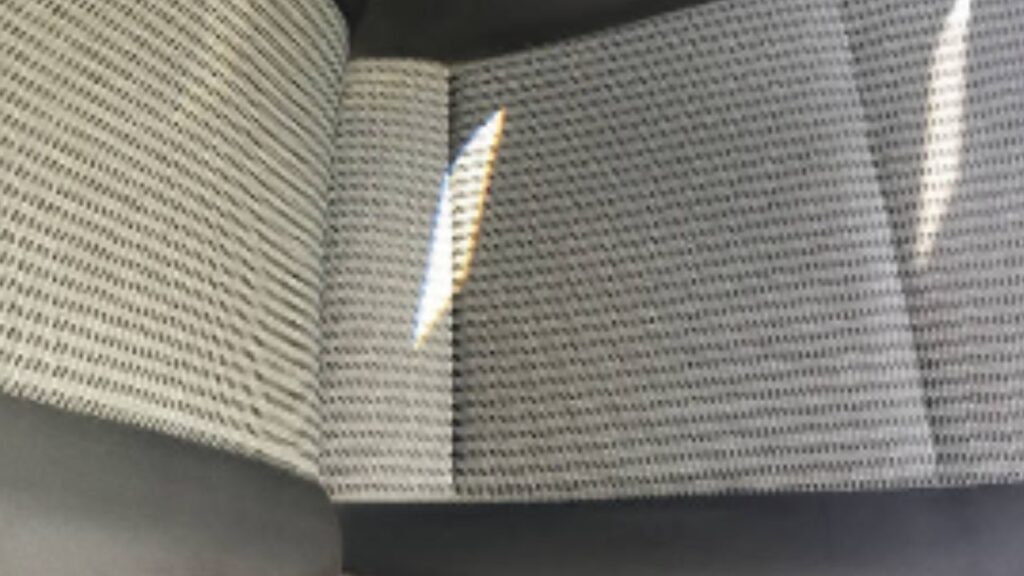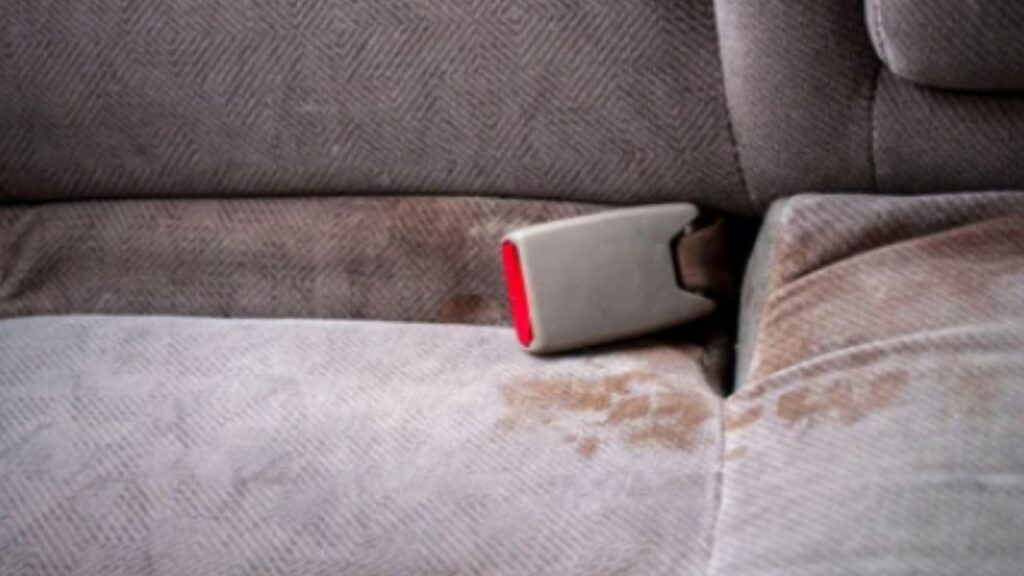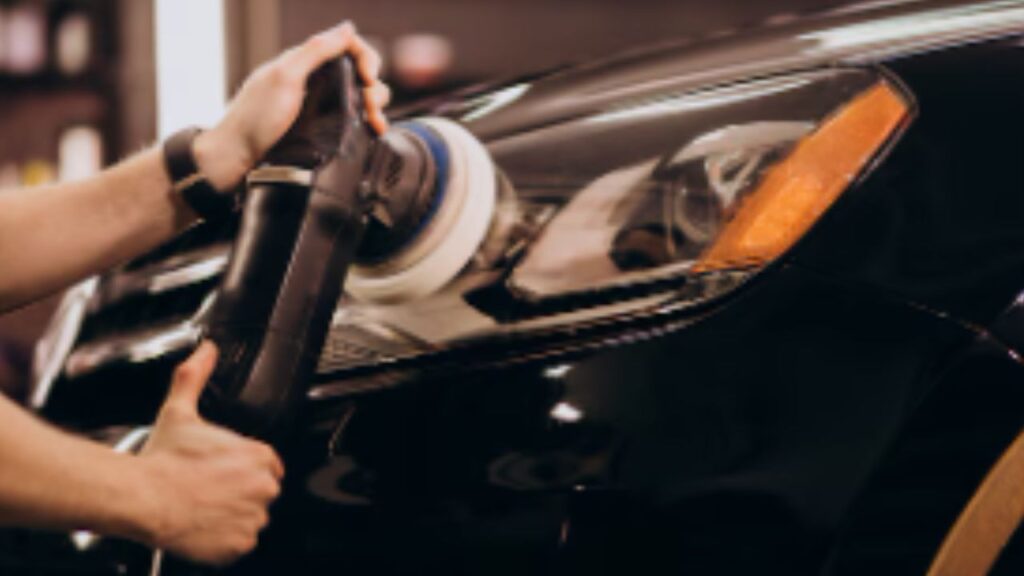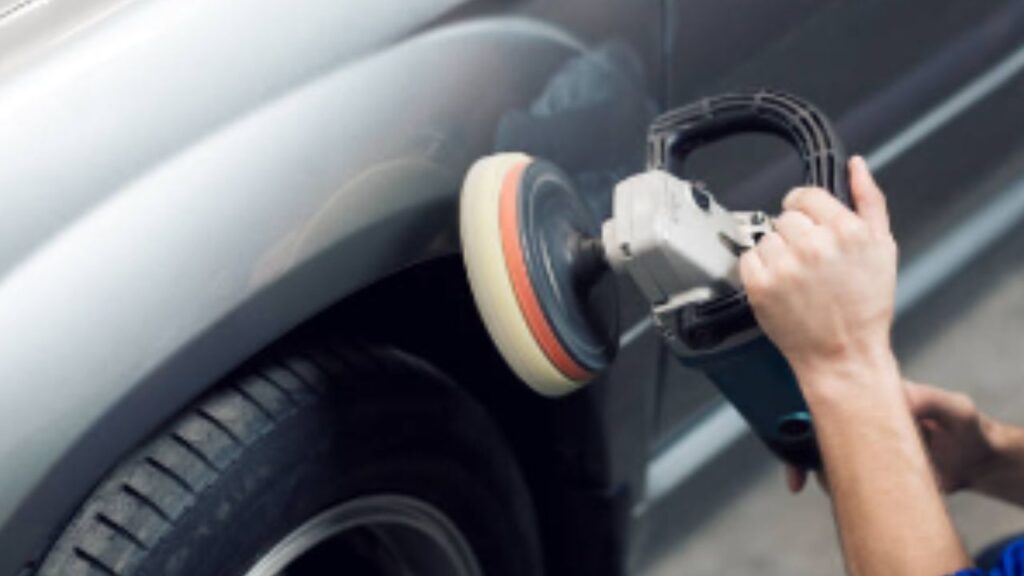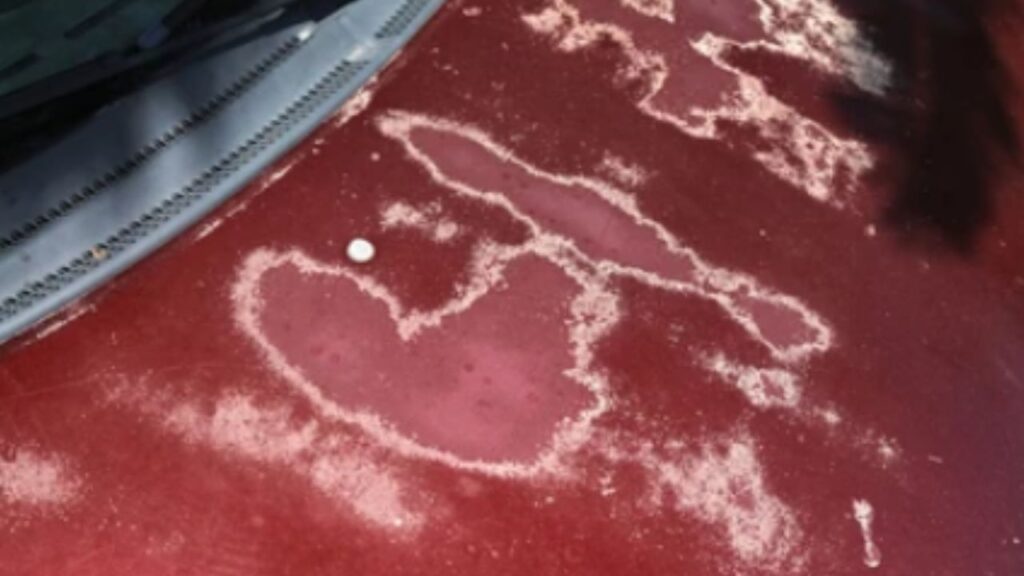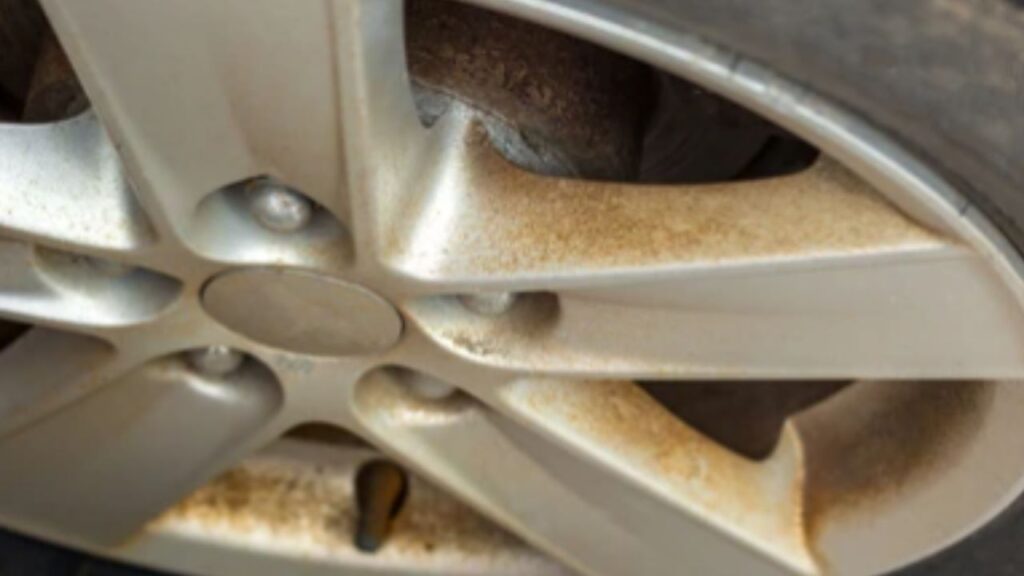Paint Protection Film (PPF) is like an invisible armor for your car’s paint. It’s a clear layer that protects your car from scratches, chips, and other things that can damage the paint. With so many choices, picking the right PPF can be confusing. Let’s make it super simple.
Table of Contents
ToggleTypes of Paint Protection Film (PPF)
PPF comes in different materials and looks, each with its special qualities:
Material Types
- Thermoplastic Polyurethane (TPU): TPU is the most popular choice for PPF. It’s really strong and can bend without breaking. It’s also special because it can fix small scratches and swirl marks by itself when it gets warm, like magic!
- Polyvinyl Chloride (PVC): PVC is a cheaper kind of PPF, but it’s not as strong as TPU and can’t fix itself like TPU can.
Finish Options
- Gloss: Glossy PPF makes your car look extra shiny like it’s brand new.
- Matte: Matte PPF gives your car a unique look without any shine. It’s like a cool, secret agent car.
- Satin: Satin PPF is somewhere between glossy and matte. It gives your car a little bit of shine, but not too much.
- Clear: Clear PPF is invisible. It protects your car without changing how it looks at all.
Pre-cut vs. Bulk Film
- Pre-cut Kits: Pre-cut PPF kits are made to fit your car perfectly, like a puzzle. They’re easier to put on, but they might not cover every single part of your car’s paint.
- Bulk Rolls: Bulk PPF rolls are big and can be cut to fit any car. They can cover more of your car’s paint, but it’s better to have a professional put them on to make sure it’s done right.
Where Can You Put PPF?
PPF can be put on lots of different parts of your car, both inside and out:
Outside Your Car:
- Full Body: You can cover your whole car with PPF for the most protection.
- Front Bumper: This is a good place for PPF because it gets hit by bugs and rocks a lot.
- Hood: The hood can get scratched easily, so PPF can help.
- Fenders: Fenders can get chipped by rocks, so PPF is a good idea.
- Side Mirrors: Mirrors can get scratched or broken, so PPF can keep them safe.
- Door Edges: Door edges can get scratched when you open and close the doors. PPF can help.
- Rocker Panels: Rocker panels are the parts of your car under the doors. They can get dirty and scratched, so PPF can keep them clean.
- Rear Bumper: The rear bumper can get scratched when you’re parking or loading things in your trunk. PPF can protect it.
Inside Your Car:
- Dashboard: The dashboard can get scratched by the sun or by things you put on it.
- Door Panels: Door panels can get scratched when you get in and out of the car.
- Center Console: The center console can get scratched by keys or other things.
Choosing the right PPF is like choosing the right shoes for your outfit. It depends on what you like and what you need. Think about how much money you want to spend, how you want your car to look, and how much protection you want for your car’s paint. With the right PPF, your car will stay looking awesome for a long, long time!
Installation Techniques
Putting PPF on your car can be done in two ways: by a professional or by yourself. Let’s look at both options:
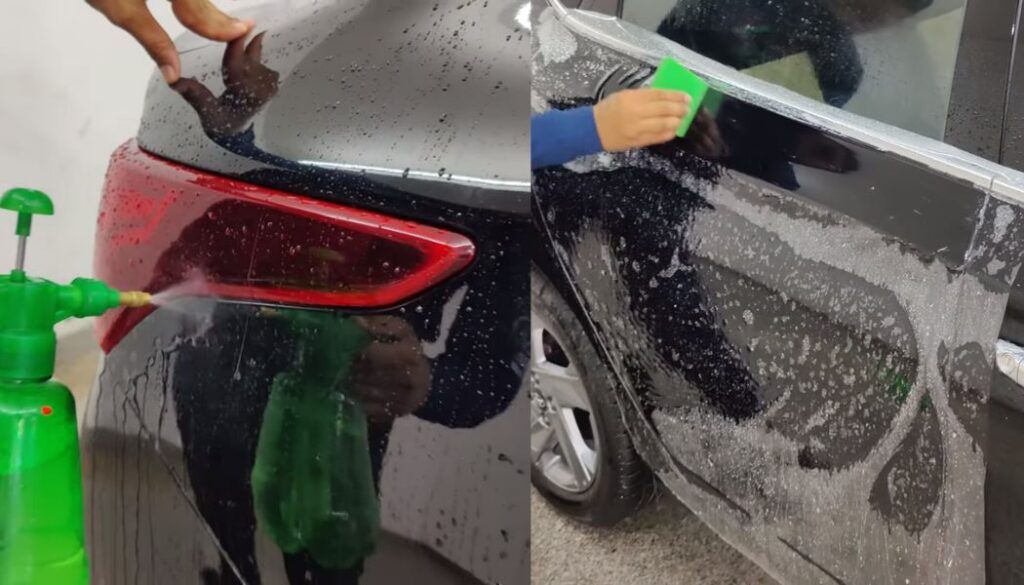
Professional Installation:
- Tools and Equipment: Professionals have special tools like squeegees, heat guns, and knives to make sure the PPF is put on perfectly. They also have clean, dust-free workspaces to keep dirt and dust away from the film.
- Certified Installers: Professionals are trained and have certificates that show they know how to put PPF on cars the right way. They have experience working with different types of cars and PPF, so you can trust they’ll do a great job.
- Installation Steps: Professionals follow a step-by-step process to get your car ready, cut the PPF to fit, and put it on smoothly. They’ll make sure there are no air bubbles, wrinkles, or other problems.
DIY Installation:
- Tools Needed: You’ll need some basic tools like a squeegee, a spray bottle filled with soapy water, and a sharp knife or razor blade. You might also need a heat gun to help the PPF stretch and stick better.
- Step-by-Step Guide: There are many helpful guides online and videos that show you how to put PPF on your car step-by-step. It’s important to follow the instructions carefully to make sure it’s done right.
- Common Mistakes: Some common mistakes when putting on PPF yourself are leaving air bubbles, cutting the PPF the wrong size, or not cleaning the car’s surface well enough before putting on the PPF. These mistakes can make the PPF look bad or not protect your car as well as it should.
Whether you choose professional installation or DIY, putting PPF on your car is a great way to protect its paint and keep it looking new for a long time. Just remember to be patient and careful, and your car will thank you!
Maintenance and Care
You’ve put a special shield on your car, called PPF, to keep the paint looking awesome. Way to go! But just like anything else, PPF needs a little TLC to stay in top shape. Don’t worry, it’s easy peasy.
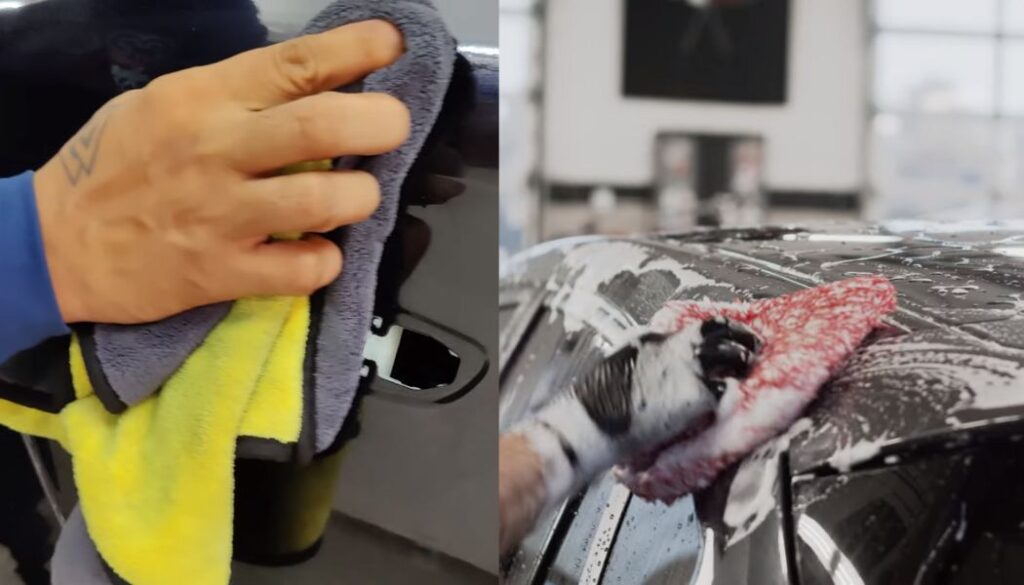
Cleaning Methods: Keeping Your PPF Sparkling Clean
- Use the Right Soap: Think of your PPF like your own skin – it needs special soap that won’t hurt it. Look for car wash soap made just for PPF. These are super gentle and safe. Ask the people who put the PPF on your car, or a car expert, which soap is best.
- Wash it the Right Way: Use a soft, fluffy sponge or cloth to wash your car. Don’t scrub hard – just be gentle. Rinse all the soap off really well so it doesn’t leave any sticky stuff behind. Then dry your car with a clean, soft towel so it doesn’t get water spots. It’s also best to wash your car in the shade, not in the hot sun.
How Long Will PPF Last?
- PPF Can Last a Long Time: If you take good care of it, the PPF on your car can last for many years – maybe even 10 years or more! That’s like having a superhero protect your car’s paint for a super long time.
- Things That Can Hurt PPF: Just like the sun can be too strong for our skin, it can also hurt PPF. So can hot or cold weather, the salt they put on roads in the winter, and even bird poop! Yuck! Washing your car with the wrong soap can also make the PPF not last as long.
Fixing Little Oopsies:
- Scratches Can Heal Themselves: Some PPF is made of a special material that can fix little scratches all by itself, like magic! If a scratch doesn’t go away on its own, a car expert can help fix it.
- Replacing the Whole Thing: If something really bad happens to the PPF, like a big rock hits it, you might need to replace the whole piece. It’s better to have a car expert do this so they can make sure it’s put on correctly.
Taking care of your car’s PPF is super easy. Just remember to use the right soap, wash it gently, and be aware of things that can wear it out. Then your car will look amazing for a long, long time!
Benefits and Drawbacks
Thinking about giving your car a special shield? That’s what Paint Protection Film (PPF) is like – a clear, tough layer that sticks to your car’s paint. But before you decide, it’s good to know the ups and downs of PPF.
The Good Stuff: Why PPF is Awesome
- PPF Protects Against Scratches: PPF is like a superhero for your car’s paint. It can stop those annoying scratches from keys, bushes, and even tiny rocks that jump up from the road.
- PPF Protects Against the Sun: The sun’s rays can make your car’s paint look dull and old over time. PPF is like sunscreen for your car, keeping the paint looking bright and colorful.
- PPF Protects Against Nasty Chemicals: Bird poop, tree sap, and other icky things can hurt your car’s paint. But PPF helps to keep these things from doing any damage.
- PPF Keeps Your Car Looking New: PPF helps your car’s paint stay shiny and new for a long, long time. This is super helpful if you ever want to sell your car because people will want to pay more for a car that looks great.
- PPF Can Make Your Car Shinier: If you choose the kind of PPF that’s shiny, it can make your car look even shinier than it did before. It’s like giving your car a super sparkle!
The Not-So-Good Stuff: Things to Think About
- PPF Can Be Expensive: Putting PPF on your car can cost a lot of money, especially if you have a big car or want to cover the whole thing. It’s like buying a fancy outfit for your car.
- PPF Can Be Tricky to Put On: Putting PPF on your car isn’t something you can just do at home. It takes special skills and tools to do it right. If it’s not done right, it might not look good or protect your car as well as it should. That’s why it’s usually best to let a professional do it.
- Some PPF Can Turn Yellow: Some types of PPF can turn a little bit yellow over time, especially if they get a lot of sun. This doesn’t happen with all PPF, but it’s something to think about.
So, is PPF right for your car? It’s up to you! Think about how much protection you want for your car’s paint, how much money you want to spend, and if you’re okay with the possibility of it turning a little yellow over time. If you decide to get PPF, it’s like giving your car a superpower to fight against scratches, the sun, and other things that can hurt its paint.
Market and Brands
So you’ve decided to get PPF for your car. Awesome! But with so many brands out there, it can be hard to know which one to choose. Let’s take a look at some of the biggest names in the PPF game.
The Big Names in PPF:
- 3M: This is a super well-known brand that makes all kinds of things, not just PPF. Their PPF is known for being tough and long-lasting.
- XPEL: XPEL is another big player in the PPF world. They’re famous for their self-healing PPF, which can make little scratches disappear like magic.
- SunTek: SunTek is a popular choice for people who want PPF that looks super clear and invisible on their car.
- Llumar: Llumar makes different kinds of PPF, including some that can make your car look extra shiny.
- Avery Dennison: Avery Dennison is known for making PPF that’s easy to put on. This can be a good choice if you’re planning to do it yourself.
Comparing the Brands:
- Performance: Each brand has its strengths and weaknesses. Some might be better at resisting scratches, while others might be better at protecting against the sun’s rays. It’s important to do your research and figure out which one is best for your needs.
- Cost: PPF can be expensive, but some brands are more expensive than others. It’s a good idea to compare prices and see which one fits your budget.
- What People Say: One of the best ways to figure out which brand is best is to read what other people are saying. Look for reviews online and see what other car owners have to say about their experiences with different PPF brands.
The Bottom Line:
Choosing the right PPF brand is like picking the right team for a game. You want a team that’s strong, reliable, and fits your style. Do your research, compare the different brands, and read reviews to find the PPF that’s perfect for your car.
Technological Advancements
PPF is always improving, and there are some amazing new features that make it even better.
Self-Healing Properties
Some PPF can actually fix itself! If it gets small scratches or swirl marks, the PPF can heal itself and make the scratches disappear.
- Heat Activation: Some PPF uses heat from the sun or a special tool to start the healing process.
- Scratch Repair Mechanisms: The PPF is made of special materials that can move and fill in the scratches, making them disappear.
Water-Repelling Coatings
Another cool feature is a coating that makes water slide right off the PPF.
- Water Repellency: This means water beads up and rolls away, so it doesn’t leave spots or marks on your car.
- Stain Resistance: The coating also helps protect against stains from things like bird droppings and tree sap.
Nano Coatings
Nano coatings are super tiny coatings that make PPF even stronger.
- Enhanced Durability: They make the PPF harder to scratch or damage, so it lasts longer.
- Improved Clarity: They also help the PPF stay clear and invisible, so you don’t even notice it’s there.
Regulations and Standards
The people who make PPF have to follow rules to make sure it’s safe for people and the environment, and that it works well.
Industry Standards
There are special rules that PPF companies agree to follow to make sure their product is good quality and does what it’s supposed to do.
- ISO Standards: These rules come from a group called the International Organization for Standardization. They make sure the PPF is a certain thickness, sticks well, and lasts a long time.
- ASTM Standards: These rules come from the American Society for Testing and Materials. They check the PPF’s physical and chemical properties, like how strong it is and what it’s made of.
Environmental Regulations
There are also rules about how PPF is made and thrown away to protect the environment.
- VOC Emissions: These are chemicals that can be released into the air when PPF is put on your car. There are limits on how much of these chemicals can be released.
- Disposal Guidelines: There are rules about how to get rid of PPF safely so it doesn’t pollute the soil or water.
Warranty and Guarantees
Most PPF companies offer a warranty, which means they promise to fix or replace the PPF if something goes wrong.
- Manufacturer Warranties: This covers problems with the PPF itself, like if it peels or fades.
- Installation Guarantees: This covers problems caused by the person who put the PPF on your car, like if it bubbles or doesn’t stick properly.
Cost and Pricing
The Paint Protection Film Cost depends on a few things.
Factors Influencing Cost
- Material Quality: Better quality PPF with special features, like the self-healing kind, will cost more.
- Installation Complexity: If your car has a lot of curves or hard-to-reach areas, it might cost more to put on the PPF.
- Vehicle Type: Bigger cars need more PPF, so it will cost more to cover them.
Price Ranges
PPF comes in different price ranges to fit different budgets.
- Budget Options: This is basic PPF that will protect your car’s paint but might not have all the extra features like self-healing or water repellency.
- Mid-Range Options: This PPF usually has some of the extra features and is a good balance of price and quality.
- Premium Options: This is the best PPF with all the latest technology, like self-healing, water repellency, and nano coatings. It will cost the most, but it offers the best protection for your car’s paint.
Click this link to know details about Paint Protection Film Cost.
Customer Considerations
Before you decide to get PPF for your car, here are a few things to consider:
Selection Criteria
- Vehicle Type: The type of car you have might influence the kind of PPF that’s best for it. Some PPF is better suited for certain car shapes or paint types.
- Usage Environment: If you drive on rough roads or in areas with lots of bugs or road debris, you might need a tougher PPF that can handle more wear and tear.
- Personal Preferences: Think about how much you want to spend and what features are important to you. Do you want self-healing PPF? Do you need the water-repelling coating?
Installation Locations
You have a few choices for where to get PPF put on your car:
- Authorized Dealers: Many car dealerships offer PPF installation as an extra service when you buy a new car.
- Mobile Installers: Some businesses will come to your home or workplace to put the PPF on your car.
- DIY Solutions: You can also buy PPF kits and try to install it yourself, but it can be tricky to do it right, and you might not get the best results.

